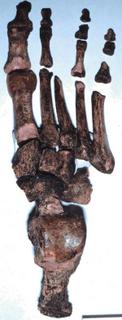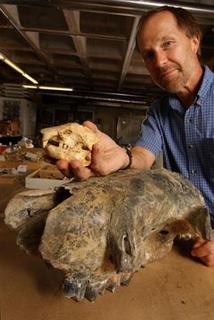It concerns, of all things, Intelligent Design.
Athletes do things that seem transcendental -- and they can also do things that are transcendentally stupid. They choke, trip and dope. Nevertheless, they possess a deep physical knowledge the rest of us can learn from, bound as we are by our ordinary, trudging, cumbersome selves. Ever get the feeling that they are in touch with something that we aren't? What is that thing? Could it be their random, mutant talent, or could it be evidence of, gulp, intelligent design?
That is how it starts. Then it goes rapidly downhill from there.
First, let's get rid of the idea that ID (intelligent design) is a form of sly creationism. It isn't. ID is unfairly confused with the movement to teach creationism in public schools.
Umm, wrong, as the wedge document clearly shows Intelligent Design is most definately a sly form of creationism.
The most serious ID proponents are complexity theorists, legitimate scientists among them, who believe that strict Darwinism and especially neo-Darwinism (the notion that all of our qualities are the product of random mutation) is inadequate to explain the high level of organization at work in the world.
And yet, all these "complexity theorists" and "legitimate scientists" have had something like fifteen years to produce some actual science and failed miserably. By the way, what the heck is a "complexity theorist" anyway? At any rate, the last I heard evolution wasn't due to random mutation. Rather it was due to a complex interplay of selection, drift and migration (to name a few) acting on genetic variabilty and mutation. I guess I should also mention historical contigency as well.
The idea, so contentious in other contexts, actually rings a loud bell in sports. Athletes often talk of feeling an absolute fulfillment of purpose, of something powerful moving through them or in them that is not just the result of training. Jeffrey M. Schwartz, a neuroscientist and research professor of psychiatry at the UCLA School of Medicine, is a believer in ID, or as he prefers to call it, "intrinsic intelligence." Schwartz wants to launch a study of NASCAR drivers, to better understand their extraordinary focus. He finds Darwinism, as it applies to a high-performance athlete such as Tony Stewart, to be problematic. To claim that Stewart's mental state as he handles a high-speed car "is a result of nothing more than random processes coming together in a machine-like way is not a coherent explanation," Schwartz said.
Darwin, it should be pointed out, wrote a whole book (called Expression of the Emotions in Man and Animals) where he did just that. But let it pass. Might not this "extraordinary focus" have something to do with the evolution of the brain? Might it not have something to do with adapting to various environments that hominids found themselves in over the course of the last 5 million years? Might come in handy if you are hunting - or being hunted.
Instead, Schwartz theorizes that when a great athlete focuses, he or she may be "making a connection with something deep within nature itself, which lends itself to deepening our intelligence." It's fascinating thought.
Umm, yes, it's called concentrating perhaps a psychology book would help with the concept. Certainly any competent neuroanatomist can explain it.
Steve Stenstrom, who played quarterback for the Bears and 49ers, works as a religious-life adviser to athletes at Stanford, where he organized a controversial forum on intelligent design last May. "I don't think it's a reach at all," he said. "Talk to any athlete, and if they really are honest, they realize that while they have worked and trained, and put a lot of effort into being great, they started with some raw material that was advantageous to them, and that it was meant to work a certain way. We all recognize that we have a certain design element."
Great, now we are getting science from football players. I think the raw material would be the genetic makeup they inherited from their parents.
A strict Darwinist would suggest this is an illusion and point out that there are obvious flaws in the body. Peter Weyand, a researcher in kinesiology and biomechanics at Rice University, observes, "Humans in the realm of the animal kingdom aren't terribly athletic."
Okay, what's the deal with Darwinism? The study of evolution has progressed quite a bit since Darwins day. Perhaps a little reading on the subject you are writing about might help.
Then we get a lot of dreck like this:
Our bodies break down a lot. If we were designed more intelligently, presumably we wouldn't have osteoporosis or broken hips when we get old. Some evolutionists suppose that the process through which people evolved from four-legged creatures to two, has had negative orthopedic consequences.
I would suggest that you consult Wilton M. Krogman's "Scars of Human Evolution" Published in Scientific American back in 1951 (VOl. 185 No. 6, pp 54-57). The fact of the matter is anyone who studies the human skeleton comes to the conclusion that the shift from quadrupedalism to bipedalism has left telltale traces. This is why Mark Prior and Kerry Woods spend so much time on the DL, this is why football players can barely walk a few years sfter retiring (ever heard of Conrad Dobler - great offensive lineman - can barely walk now).
Then we get a bunch of unitelligible stuff like this:
Schwarz finds little or nothing in natural selection to explain the ability of athletes to reinterpret physical events from moment to moment, the super-awareness that they seem to possess. He has a term for it, the ability to be an "impartial spectator" to your own actions. "The capacity to stand outside yourself and be aware of where you are," he said. "Deep within the complexities of molecular organization lies an intrinsic intelligence that accounts for that deep organization, and is something that we can connect with through the willful focus of our minds," he theorizes.
I'm not sure what any of this has to do with athletic ability?? Truth be told I'm not really sure what it has to do with, well, anything.
Crackpot speculation?
That would be my guess.
Maybe -- maybe not. ID certainly lacks a body of scientific data, and opponents are right to argue that the idea isn't developed enough to be taught as equivalent to evolution.
Ummm, actually it lacks data period. It's been something like 15 years since Intelligent Design was first proposed, so the question naturally arises. If the theory isn't developed enough now, when will it be? Surely if it's that self eveident developing Intelligent Design theory ought to be easy as crap going through a goose. Right?
But Darwin himself admitted he didn't know everything about everything. "When I see a tail feather on a peacock, it makes me sick," he once said, before he understood it was for mating.
Speaking of Darwin... in the 15 years after he published The Origin of Species he published four (I think) more works and conducted hundreds of experiments. Made it a pretty well developed theory. Why couldn't Intelligent Design do the same?
And try telling a baseball fan that pure Darwinism explains Joe DiMaggio. As Tommy Lasorda once said, "If you said to God, 'Create someone who was what a baseball player should be,' God would have created Joe DiMaggio -- and he did."
Gee, let's see... those who can hit the ball better, run faster, throw harder, catch a ball better survive and make it to the major league. Those who can't fall by the wayside. Sounds like natural selection in action to me.
None of this is to say that we shouldn't be wary of the uses for which ID might be hijacked.
One can only chuckle
In the last year, numerous states have experienced some sort of anti-evolution movement. That makes it all the more important for the layman to distinguish the various gradations between evolutionists, serious scientists who are interested in ID, "neo-Creos," and Biblical literalists.
As the Kansas school board hearing showed the difference between serious scientists who are interested in ID and "neo-Creos," and Biblical literalists is miniscule at best.
One of the things we learn in a grade school science class is a concrete way of thinking, a sound, systematic way of exploring the natural world.
Yup, that is why serious scientist don't waste their time with Intelligent Design.
Historically, scientific theorists are sandlot athletes, drawing up plays in the dirt.
I'm speechless...
Incidently,
Pharyngula has an excellent, and much less snarkier, take down as well.



 A 26,000 year-old early modern human, Dolni Vestonice 16 from the Czech Republic, showing the reduced strength of the bones of the lesser toes. It is one of three partial foot skeletons from Dolni Vestonice that shows the reduced lesser toe strength, all dating to about 26,000 years ago. (Photo Credit: Erik Trinkaus / Czech Academy of Sciences)
A 26,000 year-old early modern human, Dolni Vestonice 16 from the Czech Republic, showing the reduced strength of the bones of the lesser toes. It is one of three partial foot skeletons from Dolni Vestonice that shows the reduced lesser toe strength, all dating to about 26,000 years ago. (Photo Credit: Erik Trinkaus / Czech Academy of Sciences)































